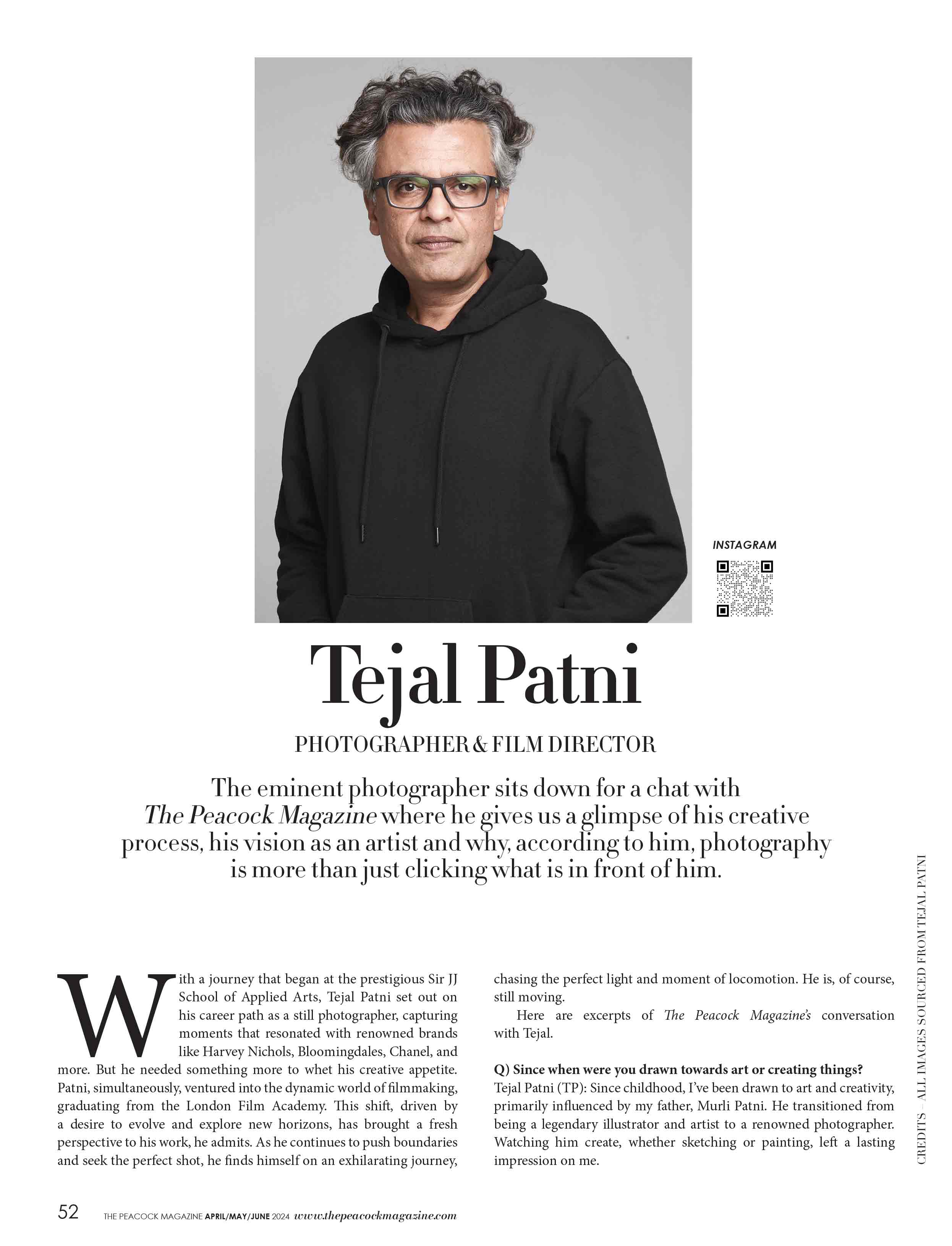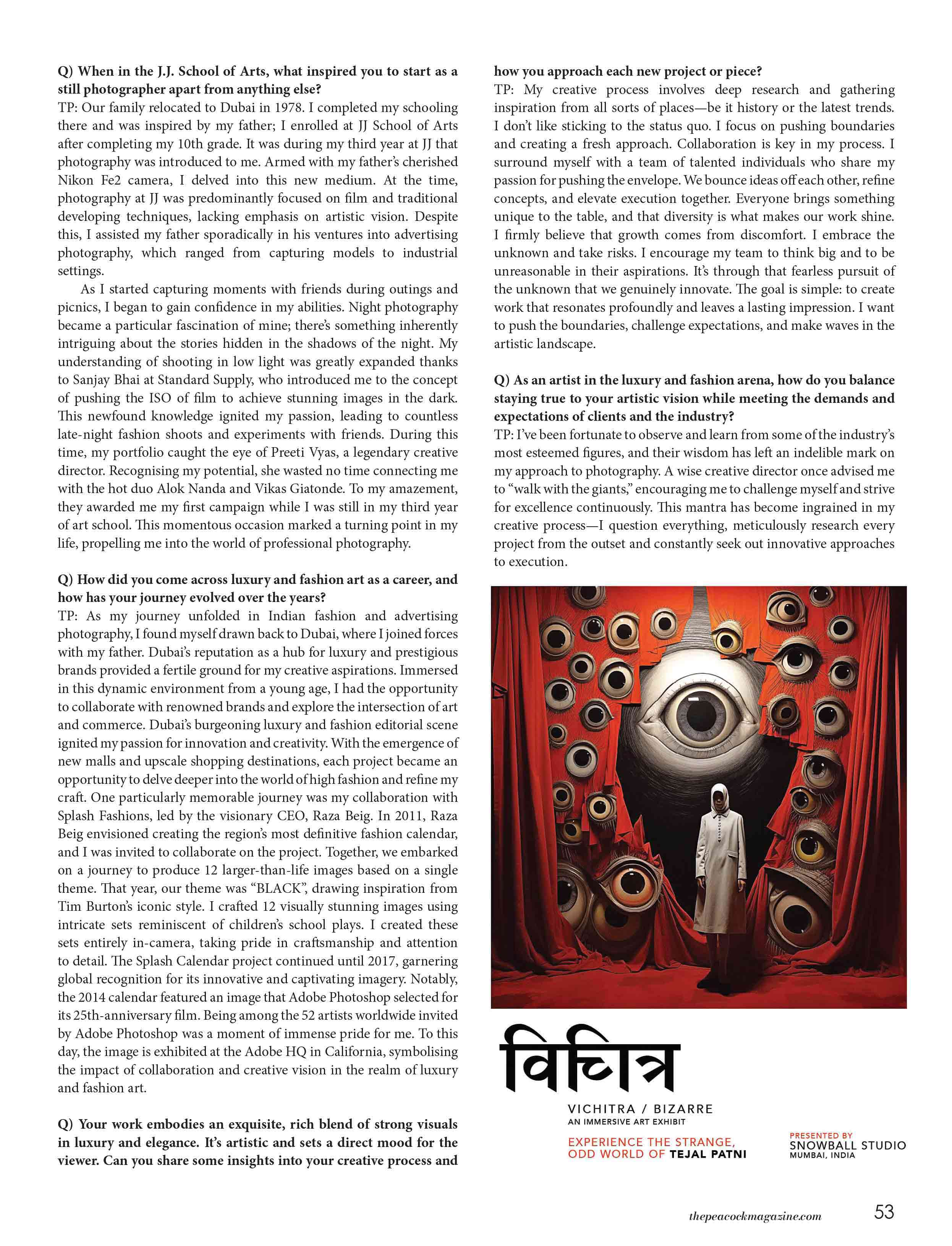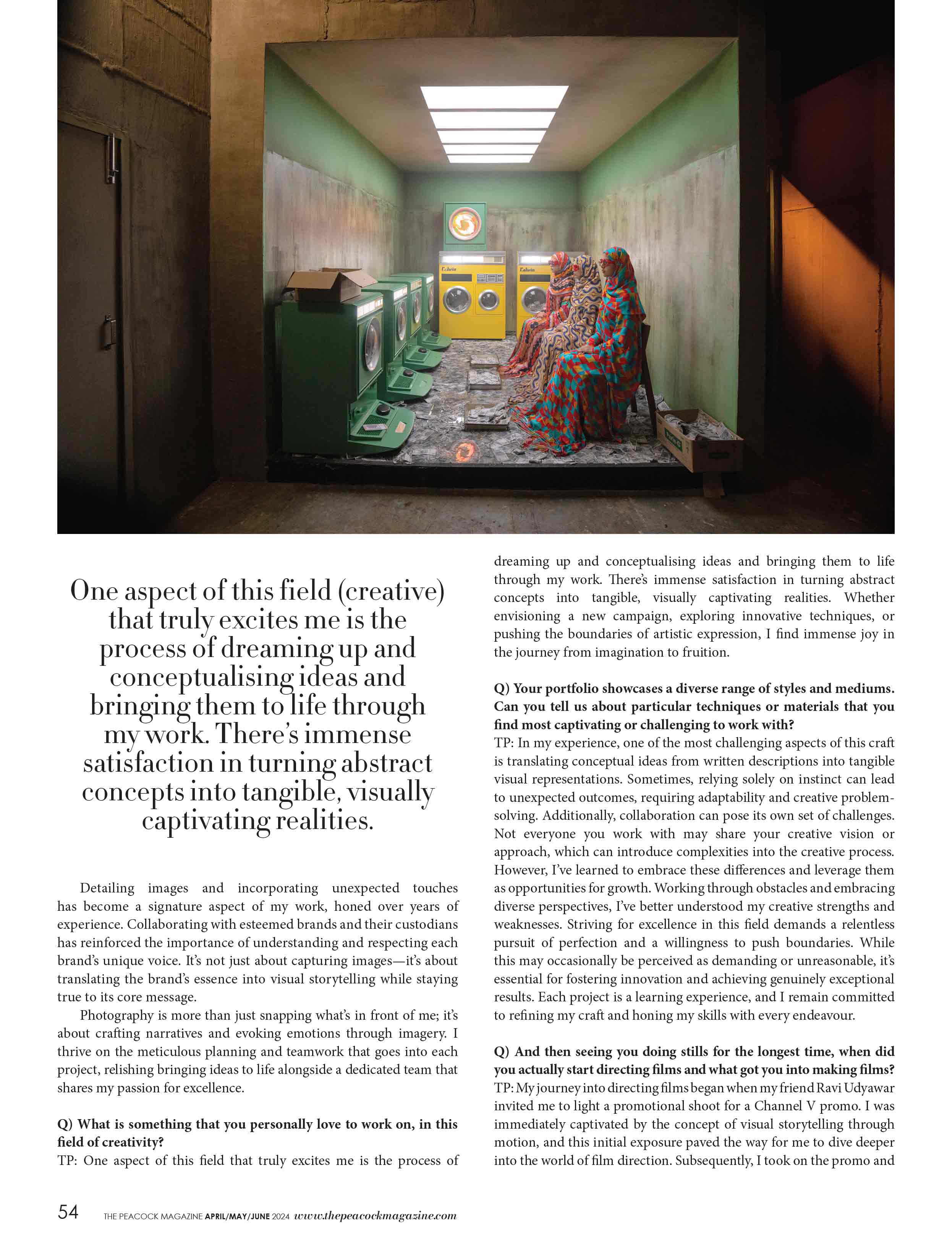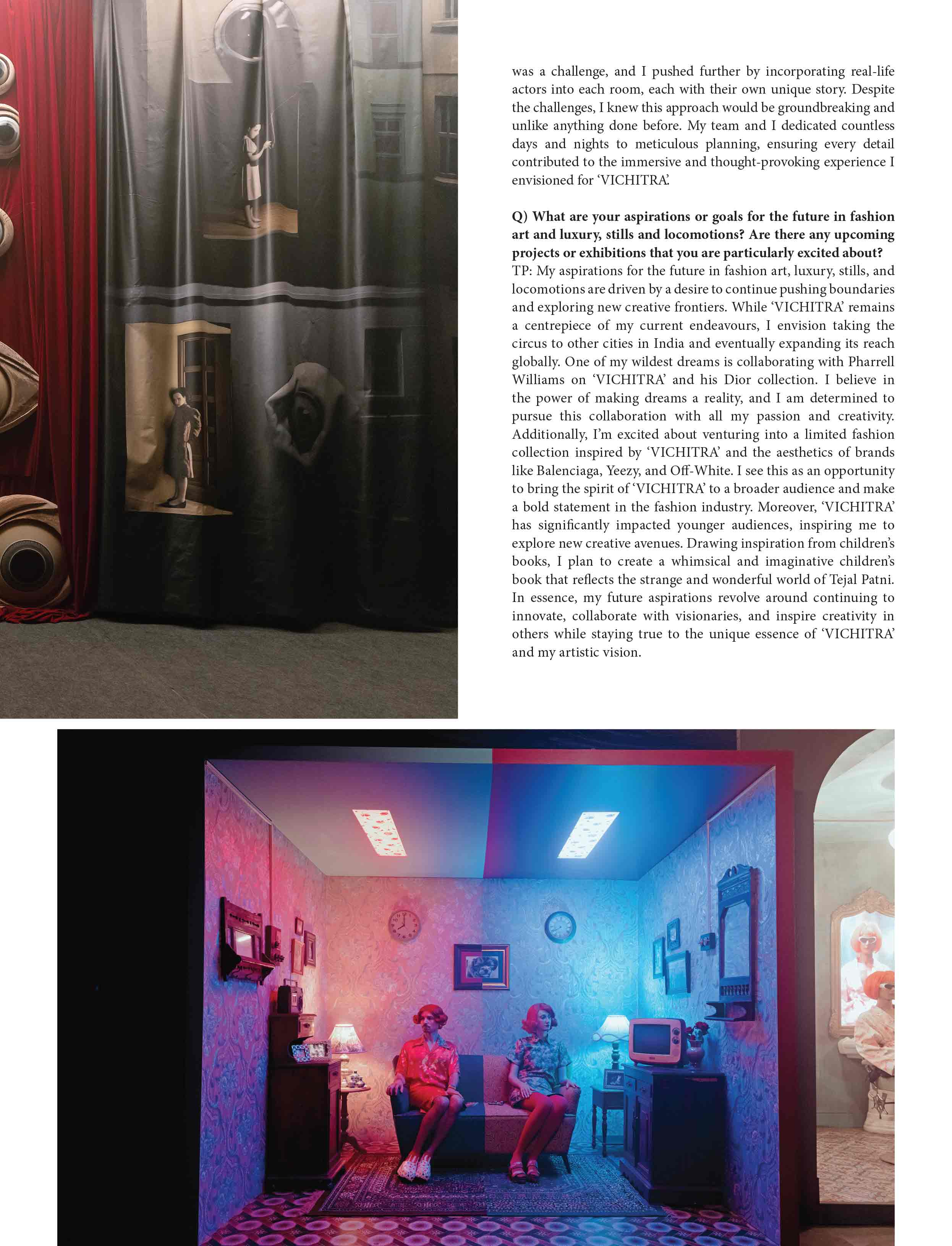
CREDITS – All images sourced from Tejal Patni
The eminent photographer sits down for a chat with The Peacock Magazine where he gives us a glimpse of his creative process, his vision as an artist and why, according to him, photography is more than just clicking what is in front of him.
With a journey that began at the prestigious Sir JJ School of Applied Arts, Tejal Patni set out on his career path as a still photographer, capturing moments that resonated with renowned brands like Harvey Nichols, Bloomingdales, Chanel, and more. But he needed something more to whet his creative appetite. Patni, simultaneously, ventured into the dynamic world of filmmaking, graduating from the London Film Academy. This shift, driven by a desire to evolve and explore new horizons, has brought a fresh perspective to his work, he admits. As he continues to push boundaries and seek the perfect shot, he finds himself on an exhilarating journey, chasing the perfect light and moment of locomotion. He is, of course, still moving.
Q) Since when were you drawn towards art or creating things?
Tejal Patni (TP): Since childhood, I’ve been drawn to art and creativity, primarily influenced by my father, Murli Patni. He transitioned from being a legendary illustrator and artist to a renowned photographer. Watching him create, whether sketching or painting, left a lasting impression on me.

Q) When in the J.J. School of Arts, what inspired you to start as a still photographer apart from anything else?
TP: Our family relocated to Dubai in 1978. I completed my schooling there and was inspired by my father; I enrolled at JJ School of Arts after completing my 10th grade. It was during my third year at JJ that photography was introduced to me. Armed with my father’s cherished Nikon Fe2 camera, I delved into this new medium. At the time, photography at JJ was predominantly focused on film and traditional developing techniques, lacking emphasis on artistic vision. Despite this, I assisted my father sporadically in his ventures into advertising photography, which ranged from capturing models to industrial settings.
As I started capturing moments with friends during outings and picnics, I began to gain confidence in my abilities. Night photography became a particular fascination of mine; there’s something inherently intriguing about the stories hidden in the shadows of the night. My understanding of shooting in low light was greatly expanded thanks to Sanjay Bhai at Standard Supply, who introduced me to the concept of pushing the ISO of film to achieve stunning images in the dark. This newfound knowledge ignited my passion, leading to countless late-night fashion shoots and experiments with friends. During this time, my portfolio caught the eye of Preeti Vyas, a legendary creative director. Recognising my potential, she wasted no time connecting me with the hot duo Alok Nanda and Vikas Giatonde. To my amazement, they awarded me my first campaign while I was still in my third year of art school. This momentous occasion marked a turning point in my life, propelling me into the world of professional photography.
Q) How did you come across luxury and fashion art as a career, and how has your journey evolved over the years?
TP: As my journey unfolded in Indian fashion and advertising photography, I found myself drawn back to Dubai, where I joined forces with my father. Dubai’s reputation as a hub for luxury and prestigious brands provided a fertile ground for my creative aspirations. Immersed in this dynamic environment from a young age, I had the opportunity to collaborate with renowned brands and explore the intersection of art and commerce. Dubai’s burgeoning luxury and fashion editorial scene ignited my passion for innovation and creativity. With the emergence of new malls and upscale shopping destinations, each project became an opportunity to delve deeper into the world of high fashion and refine my craft. One particularly memorable journey was my collaboration with Splash Fashions, led by the visionary CEO, Raza Beig. In 2011, Raza Beig envisioned creating the region’s most definitive fashion calendar, and I was invited to collaborate on the project. Together, we embarked on a journey to produce 12 larger-than-life images based on a single theme. That year, our theme was “BLACK”, drawing inspiration from Tim Burton’s iconic style. I crafted 12 visually stunning images using intricate sets reminiscent of children’s school plays. I created these sets entirely in-camera, taking pride in craftsmanship and attention to detail. The Splash Calendar project continued until 2017, garnering global recognition for its innovative and captivating imagery. Notably, the 2014 calendar featured an image that Adobe Photoshop selected for its 25th-anniversary film. Being among the 52 artists worldwide invited by Adobe Photoshop was a moment of immense pride for me. To this day, the image is exhibited at the Adobe HQ in California, symbolising the impact of collaboration and creative vision in the realm of luxury and fashion art.
Q) Your work embodies an exquisite, rich blend of strong visuals in luxury and elegance. It’s artistic and sets a direct mood for the viewer. Can you share some insights into your creative process and how you approach each new project or piece?
TP: My creative process involves deep research and gathering inspiration from all sorts of places—be it history or the latest trends. I don’t like sticking to the status quo. I focus on pushing boundaries and creating a fresh approach. Collaboration is key in my process. I surround myself with a team of talented individuals who share my passion for pushing the envelope. We bounce ideas off each other, refine concepts, and elevate execution together. Everyone brings something unique to the table, and that diversity is what makes our work shine. I firmly believe that growth comes from discomfort. I embrace the unknown and take risks. I encourage my team to think big and to be unreasonable in their aspirations. It’s through that fearless pursuit of the unknown that we genuinely innovate. The goal is simple: to create work that resonates profoundly and leaves a lasting impression. I want to push the boundaries, challenge expectations, and make waves in the artistic landscape.
Q) As an artist in the luxury and fashion arena, how do you balance staying true to your artistic vision while meeting the demands and expectations of clients and the industry?
TP: I’ve been fortunate to observe and learn from some of the industry’s most esteemed figures, and their wisdom has left an indelible mark on my approach to photography. A wise creative director once advised me to “walk with the giants,” encouraging me to challenge myself and strive for excellence continuously. This mantra has become ingrained in my creative process—I question everything, meticulously research every project from the outset and constantly seek out innovative approaches to execution.
Detailing images and incorporating unexpected touches has become a signature aspect of my work, honed over years of experience. Collaborating with esteemed brands and their custodians has reinforced the importance of understanding and respecting each brand’s unique voice. It’s not just about capturing images—it’s about translating the brand’s essence into visual storytelling while staying true to its core message.
Photography is more than just snapping what’s in front of me; it’s about crafting narratives and evoking emotions through imagery. I thrive on the meticulous planning and teamwork that goes into each project, relishing bringing ideas to life alongside a dedicated team that shares my passion for excellence.

Q) What is something that you personally love to work on, in this field of creativity?
TP: One aspect of this field that truly excites me is the process of dreaming up and conceptualising ideas and bringing them to life through my work. There’s immense satisfaction in turning abstract concepts into tangible, visually captivating realities. Whether envisioning a new campaign, exploring innovative techniques, or pushing the boundaries of artistic expression, I find immense joy in the journey from imagination to fruition.
Q) Your portfolio showcases a diverse range of styles and mediums. Can you tell us about particular techniques or materials that you find most captivating or challenging to work with?
TP: In my experience, one of the most challenging aspects of this craft is translating conceptual ideas from written descriptions into tangible visual representations. Sometimes, relying solely on instinct can lead to unexpected outcomes, requiring adaptability and creative problem-solving. Additionally, collaboration can pose its own set of challenges. Not everyone you work with may share your creative vision or approach, which can introduce complexities into the creative process. However, I’ve learned to embrace these differences and leverage them as opportunities for growth. Working through obstacles and embracing diverse perspectives, I’ve better understood my creative strengths and weaknesses. Striving for excellence in this field demands a relentless pursuit of perfection and a willingness to push boundaries. While this may occasionally be perceived as demanding or unreasonable, it’s essential for fostering innovation and achieving genuinely exceptional results. Each project is a learning experience, and I remain committed to refining my craft and honing my skills with every endeavour.
Q) And then seeing you doing stills for the longest time, when did you actually start directing films and what got you into making films?
TP: My journey into directing films began when my friend Ravi Udyawar invited me to light a promotional shoot for a Channel V promo. I was immediately captivated by the concept of visual storytelling through motion, and this initial exposure paved the way for me to dive deeper into the world of film direction. Subsequently, I took on the promo and show director role for Channel V, where I had the opportunity to helm projects like Fashion Police for two seasons. This hands-on experience further fuelled my passion for filmmaking.

Q) Talking about films, cut to London, and graduating from the London Film Academy. What were you doing in between and what made you curious about learning filmmaking?
TP: In 2003, I decided to temporarily step away from my pursuits in photography and filmmaking to pursue formal education in London. I enrolled in a film-making programme at the London Film Academy (LFA), driven to cultivate my skills independently and learn from fellow students and professors. During my time in London, I remained dedicated to still photography, consistently taking on projects. These endeavours maintained my professional momentum and served as a source of inspiration for my budding filmmaking career. Reflecting on this choice, I can say that it is one of the most enriching experiences of my career, significantly moulding me into the filmmaker I am today.
Q) So now between static and motion pictures, which is your most favourite to work on currently and which one has the strongest hold or pull on you?
TP: I find joy and fulfilment in both static and motion pictures. Each offers its own unique set of challenges and opportunities for creativity, keeping me engaged and inspired. Currently, I don’t have a preference for one over the other; instead, I embrace the diversity of working in both static and motion formats. I thrive on the constant evolution and innovation that comes with each project, always striving to push boundaries and explore new creative avenues. What truly fuels my passion is the process of continuous learning and reinvention. Every project presents an opportunity to expand my skills and knowledge, and I approach each endeavour with curiosity and enthusiasm. However, one aspect that can be challenging is when team members doubt their abilities or question decisions excessively. Collaboration is essential in our field; each team member must trust their expertise and contribute positively to the creative process. Remembering that we are all hired for a reason can help foster a more productive and harmonious working environment, ultimately leading to better project outcomes.
Q) What do you aim to achieve in your work of still photography and films?
TP: In my work, whether still photography or filmmaking, I aim to celebrate–bring out–the artistry and creativity inherent in each project. I approach every brief with utmost seriousness and dedication, striving to exceed expectations and deliver results that meet the client’s objectives and resonate deeply with audiences. I’m not driven solely by the desire to showcase my skills or talent. I view each project as an opportunity to contribute meaningfully to the larger creative landscape. By immersing myself fully in the vision and goals of each assignment, I seek to create work that is not only visually stunning but also emotionally impactful and culturally relevant. Ultimately, my goal is to produce work that inspires, entertains, and leaves a lasting impression—a testament to visual storytelling’s power and the creative spirit’s limitless potential.
Q) From still photography and filmmaking, how did you think about making your long-due debut ’VICHITRA’ the immersive art exhibition you installed recently in Worli, Mumbai at Snowball Studios?
TP: For a while, I had been hesitant about showcasing my work publicly. I’ve always been reserved regarding self-promotion—it’s just not my style. However, after receiving several invitations to exhibit my work, I considered the possibility more seriously. I knew that if I embarked on this journey, I wanted it to be more than just a conventional art exhibition featuring images on walls. I craved something that truly reflected my identity as an artist and an individual—something authentic and original. That’s when the idea for VICHITRA was born. The word “Vichitra” means “bizarre”, which resonates with me deeply. It took me some time to realise that there’s a certain eccentricity to both my work and my approach to life. Embracing this realisation, I knew I was onto something special—something that would showcase my art and speak to the essence of who I am. So, despite my initial reservations, I ultimately decided to take the leap and bring VICHITRA to life. It wasn’t just about showcasing my past work; it was about embarking on a new creative journey that would nourish my soul and allow me to express myself authentically.

Q) What went behind the brainstorming sessions of ‘VICHITRA’?
What inspired you to create a bizarre immersive art experience?
TP: The brainstorming sessions for ‘VICHITRA’ began two years ago during a winter shoot in Delhi. I found myself in a remote part of the city with little to do, so I spent hours observing and capturing images and time lapses of an unfinished building across the road from me. Despite its incomplete state, people lived there, and some rooms even lacked walls. It was as if I was peering into their lives, yet they remained oblivious to my presence. This experience sparked a fascination within me. It made me realise how we often live in structures and coexist with others without truly knowing them. The idea of peering into someone else’s life, even metaphorically, intrigued me deeply. We humans are inherently curious and sometimes invasive about each other’s lives. This curiosity and observation of human behaviour became the foundation for ‘VICHITRA’, my immersive art exhibit. I wanted to challenge conventional notions of art exhibitions by creating an experience that would immerse visitors in the lives of others, blurring the lines between reality and art. However, bringing this vision to life was no small feat. Communicating the concept was a challenge, and I pushed further by incorporating real-life actors into each room, each with their own unique story. Despite the challenges, I knew this approach would be groundbreaking and unlike anything done before. My team and I dedicated countless days and nights to meticulous planning, ensuring every detail contributed to the immersive and thought-provoking experience I envisioned for ‘VICHITRA’.

Q) What are your aspirations or goals for the future in fashion art and luxury, stills and locomotions?
Are there any upcoming projects or exhibitions that you are particularly excited about?
TP: My aspirations for the future in fashion art, luxury, stills, and locomotions are driven by a desire to continue pushing boundaries and exploring new creative frontiers. While ‘VICHITRA’ remains a centrepiece of my current endeavours, I envision taking the circus to other cities in India and eventually expanding its reach globally. One of my wildest dreams is collaborating with Pharrell Williams on ‘VICHITRA’ and his Dior collection. I believe in the power of making dreams a reality, and I am determined to pursue this collaboration with all my passion and creativity. Additionally, I’m excited about venturing into a limited fashion collection inspired by ‘VICHITRA’ and the aesthetics of brands like Balenciaga, Yeezy, and Off-White. I see this as an opportunity to bring the spirit of ‘VICHITRA’ to a broader audience and make a bold statement in the fashion industry. Moreover, ‘VICHITRA’ has significantly impacted younger audiences, inspiring me to explore new creative avenues. Drawing inspiration from children’s books, I plan to create a whimsical and imaginative children’s book that reflects the strange and wonderful world of Tejal Patni. In essence, my future aspirations revolve around continuing to innovate, collaborate with visionaries, and inspire creativity in others while staying true to the unique essence of ‘VICHITRA’ and my artistic vision.
